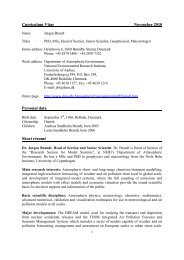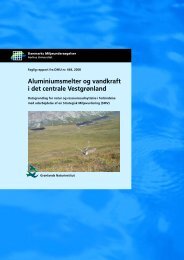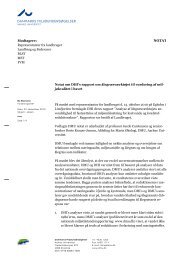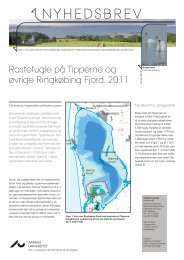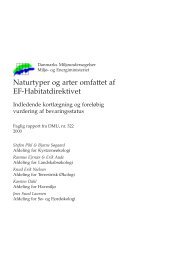Spatial distribution of emissions to air - the SPREAD model
Spatial distribution of emissions to air - the SPREAD model
Spatial distribution of emissions to air - the SPREAD model
Create successful ePaper yourself
Turn your PDF publications into a flip-book with our unique Google optimized e-Paper software.
3. Area sources (AS) cover <strong>the</strong> remaining FC and corresponding <strong>emissions</strong><br />
for stationary combustion. The FC for AS are calculated as <strong>the</strong><br />
difference between <strong>the</strong> FC given in <strong>the</strong> Danish energy statistics published<br />
by <strong>the</strong> DEA (DEA, 2009) and <strong>the</strong> sum <strong>of</strong> LPS and PS.<br />
/36<br />
Emissions from LPS are implemented in <strong>the</strong> inven<strong>to</strong>ry system in one <strong>of</strong><br />
three ways:<br />
1. FC and <strong>emissions</strong> are given in environmental reports or similar plant<br />
specific reports at part level.<br />
2. FC is given at part level but <strong>emissions</strong> are aggregated for some or all<br />
parts.<br />
3. FC is given while <strong>emissions</strong> are estimated according <strong>to</strong> standard<br />
emission fac<strong>to</strong>rs.<br />
As LPS <strong>emissions</strong> appears in different ways in <strong>the</strong> inven<strong>to</strong>ry system a<br />
module has been developed <strong>to</strong> au<strong>to</strong>mate <strong>the</strong> data handling in order <strong>to</strong><br />
extract <strong>emissions</strong> in <strong>the</strong> right order (1: direct <strong>emissions</strong>, 2: <strong>emissions</strong> estimated<br />
from activity data and emission fac<strong>to</strong>rs). Fur<strong>the</strong>r <strong>the</strong> <strong>model</strong> deals<br />
with unit conversions. The latter require some manual checks as a few<br />
LPS in <strong>the</strong> industrial sec<strong>to</strong>r do not follow <strong>the</strong> general unit definitions.<br />
The emission inven<strong>to</strong>ry database system includes CO2 <strong>emissions</strong> from<br />
biomass. These <strong>emissions</strong> are subtracted from <strong>the</strong> <strong>emissions</strong> in <strong>the</strong> spatial<br />
<strong>distribution</strong> according <strong>to</strong> <strong>the</strong> guidelines for inven<strong>to</strong>ries for UNFCCC.<br />
The bi<strong>of</strong>uels included in <strong>the</strong> inven<strong>to</strong>ry are wood and similar wood<br />
wastes, municipal waste (<strong>the</strong> biogenic part), straw, bio oil, biogas and<br />
biomass producer gas.<br />
The CO2 emission from combustion <strong>of</strong> municipal waste in stationary<br />
combustion is split in two parts; one for <strong>the</strong> fossil part and one for <strong>the</strong><br />
biogenic part <strong>of</strong> <strong>the</strong> municipal waste. Only CO2 from combustion <strong>of</strong> <strong>the</strong><br />
fossil part is included in <strong>SPREAD</strong>. The CO2 emission from <strong>the</strong> fossil part<br />
<strong>of</strong> municipal waste in stationary combustion is calculated as an area<br />
source in <strong>the</strong> Danish inven<strong>to</strong>ry system but is reallocated <strong>to</strong> LPS in<br />
<strong>SPREAD</strong> <strong>to</strong> ensure <strong>the</strong> right allocation defined by <strong>the</strong> fuel combustion at<br />
<strong>the</strong> waste incineration plants.<br />
To avoid errors in <strong>the</strong> data handling a number <strong>of</strong> checks are carried out<br />
at different steps in <strong>the</strong> <strong>model</strong>. The checks cover units, null values and<br />
sums.<br />
36<br />
The <strong>distribution</strong> <strong>of</strong> <strong>emissions</strong> from stationary combustion at point sources<br />
is based on a database from DEA including fuel consumption for<br />
each district heating or power-producing plant on fuel and combustion<br />
technology (e.g. gas turbine, stationary engine or boilers, which are fur<strong>the</strong>r<br />
divided by capacity; < 50 MW, 50 – 300 MW and > 300 MW). The<br />
DEA database is in <strong>the</strong> following referred <strong>to</strong> as EPT. Each <strong>of</strong> <strong>the</strong> 2 189<br />
production units in <strong>the</strong> 2008 EPT is assigned with SNAP 3 codes and<br />
geographical coordinates and <strong>emissions</strong> are calculated from <strong>the</strong> FC given<br />
in EPT and standard emission fac<strong>to</strong>rs for all pollutants for <strong>the</strong> specific<br />
17





